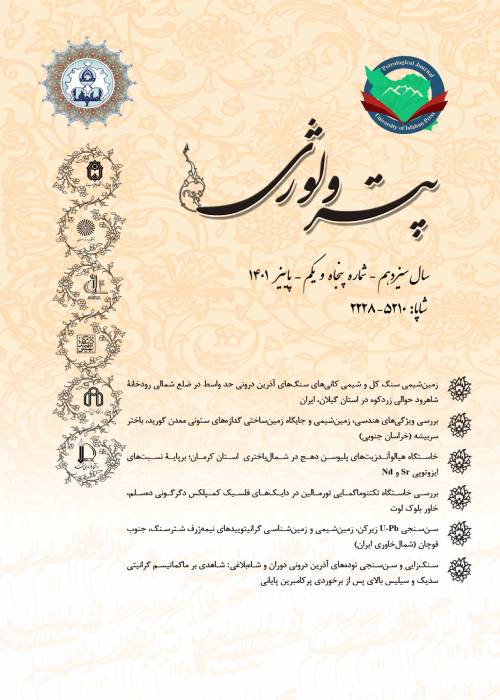Evidence for magma mixing/mingling process in the plutonic intrusive bodies of Qorveh (Kurdistan Province): with emphasis on textural and geochemical characteristics
The Qorveh batholith, in the N-Sanandaj-Sirjan Zone, comprises several gabbroic, dioritic and granitic masses intruded the Jurassic metamorphic assemblage (i.e., schist, amphibolite and marble). In spite of a number of studies which have been carried out on the various aspects of these rocks, but none of them has been studied the Mixing/Mingling model. Thus, the purpose of present study is to examine the development of the magmatic mixing process in the rocks under study based on geochemical data obtained from the enclaves and their host rocks as well as their field relationship.
In order to study the geochemical properties of intrusive rocks, 10 samples of enclaves and their host rocks. The rock composition with the least amount of alteration was selected and sent to the Pennsylvania State University of (USA) to determine the amounts of major elements by ICP-AES method, and rare and rare earth elements by ICP-MS method.
Field observations:
The enclaves, in the intrusive masses under study, are finer than that of their host rock. Therefore, they belong to the group of mafic fine-grained enclaves or microgranular mafic enclaves. (MMEs). The (MMEs) are in rounded and elliptical shapes in the host rocks and generally they have a sharp contact with their host and are composed of igneous minerals.
Petrography:
The host rocks include granite, granodiorite and monzonite, and the enclaves are dioritic and gabbroic in composition. There are similar minerals in the enclaves and their host rocks, but they often differ in the amount of minerals. They are mainly composed of mafic mineral and plagioclase. While their host rocks are characterized by smaller amounts of these minerals, the host rocks instead have higher amounts of quartz alkali feldspar. The transfer of plagioclase crystals at the common boundary of the enclave and the host rock is evidence of the magmatic mixing process in the nature of the intrusive masses studied. A number of enclaves contain megacrystals of feldspar potassium and quartz taken from the host rocks. This supports the formation of enclaves by mixing.
Geochemistry:
Geochemical studies indicate that these rocks are metaluminous, belonging to calc-alkaline magma series, having I-type characteristics. In Harker diagrams, mafic enclaves have higher MgO, TiO2, P2O5, Na2O, FeO(t), Al2O3, MnO and CaO contents than that of the host rocks, and lower K2O and SiO2 contents. The higher contents of CaO, MgO and FeO(t) in the enclaves, compared to their host, confirms their more mafic nature, which is usually proportional to the higher contents of mafic minerals in the modal of the enclaves than that of the host. The enrichment of the studied enclaves in Co, Cr, Ni display that these rocks are globules of mafic magmas mingling to felsic type.
According to field observations as well as petrographic studies, the effective factor in the evolution of magma forming intrusive masses has been mentioned as magmatic mixing. The presence of mafic fine-grained enclaves with evidence of disequilibrium textures such as feldspar with poikilitic texture, the presence of mafic masses and needle apatite, small blades-shaped plagioclase within large plagioclase or two types of plagioclases, and zoning all confirm magmatic mingling/ mixing processes. Considering that the magnesium number (Mg#) in the mantle is about 0.7 and the studied enclaves with a high magnesium number of 0.52-0.62 are evidence of the involvement of mantle-derived mafic magma. High values of Mg# in enclaves compared to their host rock (0.34-0.48) shows the mixing of magmas from the mantle with the crustal magmas. Magma mixing model has also been considered by geochemical differentiation diagrams. The trend of the samples is a curve and indicates that the effective process in magma evolution is most likely magmatic fusion. Numerous studies have shown that mafic microgranular enclaves are globules of a mantle derived mafic magma that crystallize rapidly in the injected felsic magma from the crust and, as a result, become more viscous, forming separated magmatic bubbles. In addition to the mentioned geochemical features, the enclaves are poor in LREE and LILE and enriched in Ti compared to the host rocks. Therefore, they seem to have originated from two different magmas and are placed together due to magmatic mixing.
The host rock units in the studied intrusions include granite, granodiorite, monzonite and gabbroic, dioritic enclaves. The constituent magma of this complex is in I- type, metaluminous and is in the calc-alkaline series. Based on the studies, the dominant process in the evolution of magmatic mixing. Some new findings include the presence of reversals in submerged slabs and the penetration of fleshy compounds. Which naturally have different temperatures and compositions compared to higher crustal horizon magmas, provides conditions for the occurrence and the development of the magmatic mixing process.
- حق عضویت دریافتی صرف حمایت از نشریات عضو و نگهداری، تکمیل و توسعه مگیران میشود.
- پرداخت حق اشتراک و دانلود مقالات اجازه بازنشر آن در سایر رسانههای چاپی و دیجیتال را به کاربر نمیدهد.



